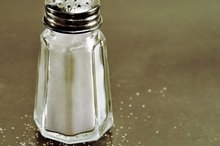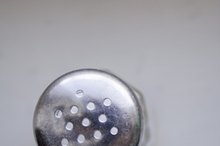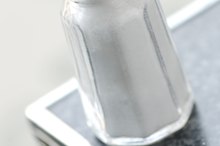Can I Have Salt Substitute if I Have High Blood Pressure?
If you are being treated for high blood pressure or prehypertension, it is likely your doctor advised you to follow a low-sodium diet. Low-sodium eating plans require careful monitoring of the salt content in meals and, in general, patients should refrain from adding salt to food for flavoring purposes. The use of salt substitutes for flavoring is, in many cases, not advised for patients with high blood pressure either.
Low-Sodium Guidelines
A low-sodium diet plan is designed to limit your salt intake and prevent unwanted increases in blood pressure. Many patients with hypertension, obesity and heart conditions are advised to follow a low-sodium diet, which typically restricts salt intake to less 1,500 milligrams per day. A physician will typically advise that you select low-sodium foods that contain less than 140 milligrams of sodium per serving, and in some cases very-low-sodium foods, with less than 35 milligrams per serving.
Safe Use of Salt Substitutes
No-Salt Diet
Learn More
The National Heart, Blood and Lung Institute warns that patients with hypertension should consult their medical provider prior to using salt substitutes to flavor food. Many salt substitutes contain potassium chloride and can be potentially harmful when used by patients with kidney problems or heart disease. Low-sodium diet guidelines and the use of salt substitutes are highly individualized depending on your personal health needs and the underlying causes of your hypertension.
Alternatives to Salt Substitutes
In general, low-sodium meal planning should be designed to limit salt intake by using alternative flavoring. Patients who tend to use excess sodium may find they have a craving for salt flavor, and this can be controlled by using less salt and avoiding the use of salt substitutes. Eating naturally low-salt foods such as fresh fruits and vegetables is an excellent way to enjoy new flavors. You should also experiment with alternative flavorings to dress or accent foods such as fresh herbs, hot sauces and citrus juices or zests.
- In general, low-sodium meal planning should be designed to limit salt intake by using alternative flavoring.
Expert Insights
What Is the NAS Diet?
Learn More
While a low-sodium diet may taste bland to some people, cutting back slowly on salt intake can help patients adjust to the new flavors. Decrease your use of salt slowly over the course of several weeks, and as your taste buds adjust you'll be less likely to crave salty flavors or need salt substitutes for seasoning.
Related Articles
References
- National Heart, Lung, and Blood Institute; Your Guide to Lowering Blood Pressure; US Department of Health and Human Services; May,2003
- MedlinePlus: Sodium in the Diet
- Food and Drug Administration, Center for Food Safety and Applied Nutrition. You May Be Surprised by How Much Salt You're Eating. Consumer Updates, 2016
- Sea salt vs. table salt, Break Up with Salt. American Heart Association.
Writer Bio
Christy Bowles has 15 years of experience in the field of education, with 10 years working in mental health and wellness. She specializes in the treatment of depression, anxiety and substance abuse, with a focus on alternative treatment modalities. Bowles holds a Master of Education from Harvard University.









